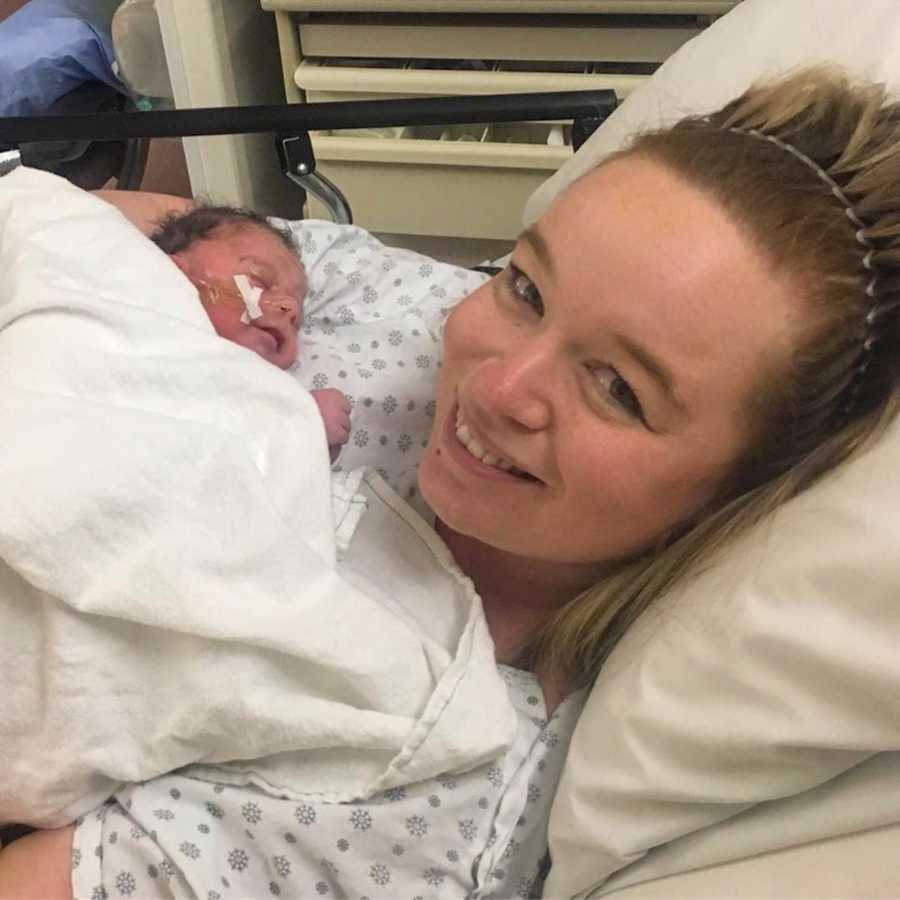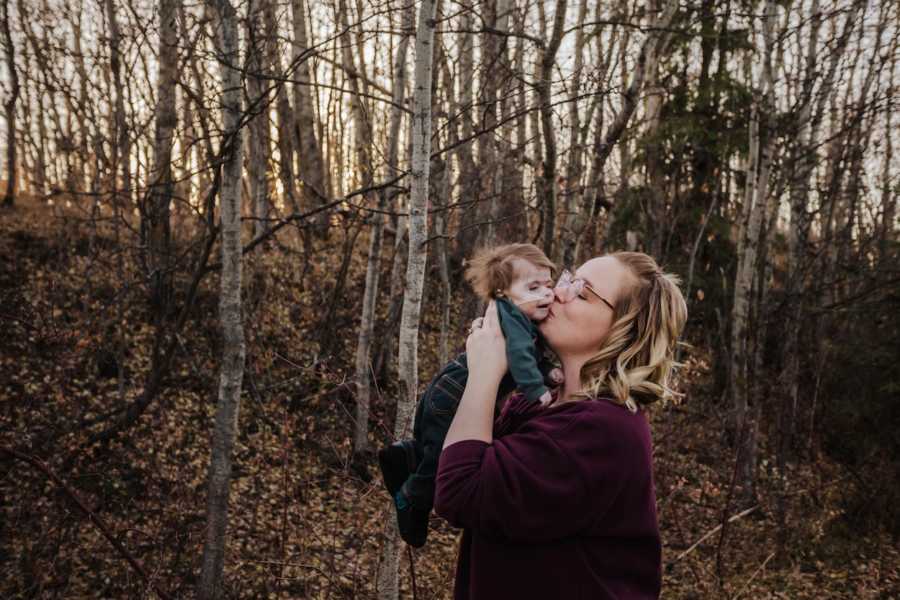“When I was 11 weeks pregnant, I started my high-risk pregnancy. When we went for our first MFM scan, we were diagnosed with a condition called Hydrops Fetalis. Hydrops Fetalis is a condition in the fetus characterized by an accumulation of fluid, or edema, in at least two fetal compartments. Our fetus had fluid in both chambers of his lungs, as well as facial edema. The hydrops worsened as the weeks went on, which left our son with only a 1% chance of survival because they feared the fluid would compress his heart and force it to quit beating. They begged me for weeks to terminate, but I refused.
‘He is very sick. He won’t be happy and will not have a good quality of life. Termination should be strongly considered,’ was rubbed into my face more than I would like to admit. I continued getting weekly MFM scans, along with a dose of steroid injections to help assist lung growth. I was heavily monitored for Mirror Syndrome, which wasn’t only fatal to my unborn son, but myself as well.
I didn’t ever go a day without having hope.
On April 18, we went for our normal weekly MFM scan, not expecting to leave hearing the words, ‘His Hydrops has resolved and we have no answer for that. He is 38 weeks and has had a plateau in growth for a few weeks now. He is healthy and we don’t want to put any more risk into the situation. You are scheduled tomorrow for a C-section.’
The next day, before going into surgery, they did the normal prepping of mothers going into C-sections, but I also met 25 health professionals who were going to be in the operating room as well with us. My husband and I gave them 100% power to do ANYTHING they possibly could when it came to resuscitation and saving our unborn son’s life. We were told to expect the worse. We were told there was a 50% chance of stillbirth. As my husband left to go scrub in, I was handed a paper to sign. A paper that stated I understood how complicated the situation was and I would not legally pursue anything if something were to happen to myself, or my son, during the surgery. After I signed the paper, I was given my spinal and froze from my neck down. I was powerless. I had to wear earplugs to focus on my breathing and help keep my blood pressure down. All I had to do at that moment was to pray…
Our sweet Preston arrived on April 19, 2018, weighing in at 5 pounds, 2 ounces, and 17.4 inches long. I heard a cry, which you think would leave any mother relieved… but not me. I was still worried.

Around 20 to 25 people rushed to the trauma room, which was attached to the OR, with Preston. My husband knew he was NOT supposed to leave our son’s side. No matter what was to happen to me, he was supposed to stay with Preston. They began to stitch me back up. Although I am sure it was minutes, it felt like HOURS went by with no update on how Preston was. All I kept asking was, ‘Is my baby okay? Is Mike still with the baby? Why has no one come to update me yet?’ My husband eventually came in and told me he was fine. He was breathing 100% on his own and they were about to head to the NICU. After about an hour in recovery, they wheeled my bed in to go see Preston for the first time. I was only allowed 5 minutes before I had to be in my room as social workers, doctors, geneticists, and therapists were going to come to talk to me. It was enough time for me to hold my son for the first time and take a quick picture. The next time I would see Preston would be about 4 hours later.
Our 3-week NICU stay was full of consults, tests, meetings, and scans. We learned Preston was healthy. Everything came back ‘normal’ or ‘negative.’ Doctors were scratching their heads because, in the womb, Preston was NOT healthy. He had a 1% to 50% chance of survival, due to the fluid that compressed against his lungs since he was 11 weeks gestation. They kept forcing test after test, trying to find SOMETHING to give them answers.
It was starting to feel like he was a science experiment.
The first 2 weeks, no one but myself and my husband was allowed to see Preston due to isolation. Our 2-year-old daughter wasn’t even allowed to come to meet her new little brother. But the day I remember the most during our NICU days, a day that I will probably remember until the last of my days, was our last consult with genetics. It was our LAST bump to pass before getting discharged and able to go home as a new family of four. Mike, myself, our social worker and her student, our NICU pediatrician, and our geneticist walked into this tiny room with two leather chairs and four other chairs they had brought in from the waiting room and a small box of Kleenex on a wooden circle table. They closed the door. I thought to myself, ‘These are the tiny rooms they bring people into to tell them something bad.’ I was EXTREMELY nervous. Everyone looked at me and asked if I was ready…and that’s when I released every emotion I had built up inside of me from my pregnancy until that very moment. My husband grabbed my hand. Our social worker asked me what was wrong and I replied, ‘I am scared you are all going to tell me that my son is going to die.’
After a short moment, the pediatrician smiled at me and replied, ‘Jessica, your son is healthy and has shown us great things since being born. He isn’t dying. He is a miracle.’
Our geneticist continued to tell us about how she suspected Preston to have a genetic condition called Cornelia de Lange Syndrome. We have never heard of this syndrome before and didn’t have any answers to any of our questions, which was why we decided to send Preston’s blood to Sweden for further genetic testing. 2 days later we were discharged and about 4 months later, we got the results… Preston has a ‘Heterozygous NIPBL Variant of Uncertain Significance’ gene mutation. To our knowledge, Preston is the only one recorded worldwide (so far) with the change in the region of Exon 31.
It is estimated that 1 out of 10,000 kids ever gets diagnosed with CdLS. It affects males and females equally and is seen in all races. The severity of CdLS ranges from mild to severe but all CdLS share similar characteristics, such as small stature, joined eyebrows, long eyelashes, upturned nose, and thin downturned lips. In 99% of cases, the gene change is sporadic, not inherited, which means that change occurs randomly during conception. Many CdLS have limb differences or uniqueness of hands. They all have a full head of hair, which naturally grows in a faux hawk. Preston has mild physical features of the syndrome. He does have a few challenges such as mild hearing impairment, nearsightedness, a partial joining of the first and second toes, gastroesophageal reflux, and feeing problems. He is also developmentally delayed in certain things but excels in other age-appropriate areas. He is fed with an NG Tube (a feeding tube inserted through the nose) until his coordination improves and is able to take in enough calories he needs in a day. Since Preston has been born, he has seen lots of doctors and specialists and spends most of his time at clinics, hospitals, and therapy sessions to help make his dreams become reality!
Since he was a fetus, he had plenty of doctors underestimate him. A doctor once told us, ‘He will be dependant on a wheelchair for life due to never being able to walk. You will need hospice care to live in your home to help assist you with his needs, and he will most likely need special schooling away from ‘normal kids.’ I don’t want to touch him. I don’t want to even look at him, let alone doctor him.’
Unfortunately, due to being a special needs person, there have been many times people (family, friends, and strangers) have looked at him differently or have treated him differently. They see his feeding tube and assume something is ‘wrong’ or ‘unhealthy’ with him. They see his size and hear that he is almost 2 years old and look at us like we are making a mistake and continue to avoid us like the plague. There are even a select few who mistreat Preston in ways they would never to our daughter, such as not caring to check-in, missing out, or even lying about why they can’t come to milestone celebrations.
To us parents, it makes us feel like Preston isn’t good enough or he isn’t good enough to be loved by others. We knew that after having kids, we would find out who our true friends and family are, but we never knew having a special needs child would show us who the real ones are. The stigma is out there and it’s very sad to personally experience. Preston has taught us many things but more so that inclusion, patience, having gratitude daily matters.”

This story was submitted to Love What Matters by Jessica Boyko. Do you have a similar experience? We’d like to hear your important journey. Submit your own story here. Be sure to subscribe to our free email newsletter for our best stories, and YouTube for our best videos.
Read more stories like this:
Do you know someone who could benefit from reading this? SHARE this story on Facebook with family and friends.

